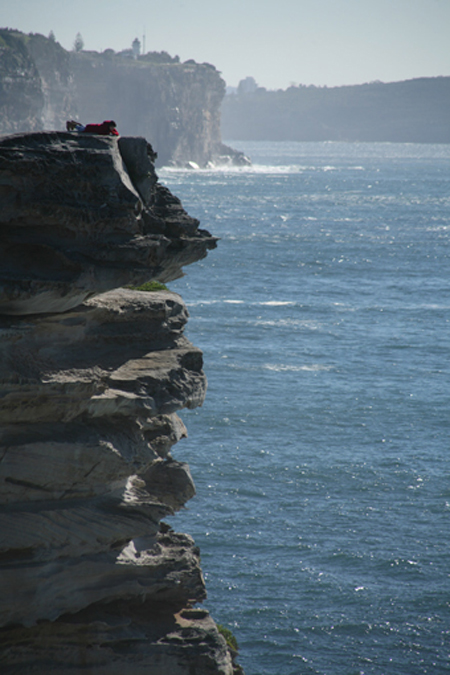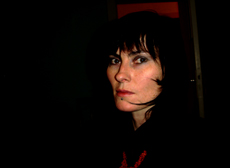vertigo
 |
Fiona McGregor |
beautiful fearTypically, facing a fear of heights on camera involves a high octane and thrilling but fleeting collision of speed and adrenaline. There were no such quick fixes to be found at MOP gallery in Sydney last month where performance artist and author Fiona McGregor screened Vertigo. A 4-hour, 50-minute edited video documentation of an entire day the artist spent lying down on the edge of a cliff at North Bondi in Sydney's east, this durational test saw McGregor confront her own anxiety in increments, abandoning dramatic moments of transformation for a more gradual and slow burn psychic unraveling. Running parallel to a performance practice that has variously challenged taboos around such areas as blood, skin and pain, McGregor is also well-known as the author of five books including the recent bestselling novel Indelible Ink. Vertigo saw McGregor shift into a more primal space beyond language. Set to an hypnotic soundscape of atmospheric coastal wind and the noise of waves lashing rocks, the video began by fixing on the artist from a distant panoramic viewpoint that emphasised the scale of the cliff's drop and revealed the extent of her vulnerability. Over a period of hours, the video slowly progressed to a closer view of the artist as she lay peering over the cliff face. The action resided simply in the languorous shifting from one camera vantage point to the next, some minor stretching and kicking about of the artist's windswept body and the subtle changes in air, water and light that occur naturally over the course of a day. Screened in a darkened space partitioned off from the rest of the gallery by black curtains, Vertigo invited the visitor to commit the time necessary to feel the impact of the video's power. The extreme nature of the risk heightened the intensity of the performance and the liminal character of the cliffs proved an effective conduit for visualising not only fear as limit but also the generative force that arises at thresholds, both psychological and physical. McGregor's position as a still figure in the landscape, meditated upon over very long and impersonal shots, conjured a contemplative space that invited consideration of a fraught relationship with the landscape more generally. What became palpable was the unease that emerges when romantic associations of the coastline with a sense of freedom or openness are stripped away and the border is re-imagined as something much rawer; a constraint, a place of longing, barren and inhospitably exposed, beautiful but beyond shelter. While the ambiguous status of the screening left me a little uncertain whether I was encountering a record of performance or an autonomous video work, there are possibilities in this grey area too. And as Vertigo represented just the first, and experimental, screening in an ongoing series inspired by water, there is undoubtedly much room for future installments to further map the complex influence this sometimes troubling yet strangely energising substance exerts on the Australian cultural psyche. Ella Mudie Fiona McGregor, Vertigo, MOP Projects, Sydney, Feb 10-27 2011 www.fionamcgregor.com |
 |
Fiona McGregorinterviewIn translating this performance into a video work how did you select the different vantage points? It's a place that I've walked a lot and it's quite a favourite place of mine so as I started to think up the performance I began mentally mapping out those shots as I walked around. And because I've been going to that place for nearly 20 years the development of Vertigo really bothered me because it was an important place and I didn't want this fear to get in the way of my enjoyment of the place. So it just came to me slowly and I took some photos and that had to be refined in terms of how to set up the camera. Did the realisation of the performance match your expectations and was it a psychologically consistent experience? I considered this performance to be more of a psychological test and underestimated the effect it had on my body. It wasn't consistent because of the intense fear I was going through and also because what I was doing to myself I haven't done in any other performance. Initially there's this ongoing terror and very strong reactions to that and then I got over it because I had to, and then it was all visual stimuli—and in a way this became a source of enjoyment and was soothing. The mind is always thinking about a million and one other things but I started to really enjoy the environment. Then, as the psychological torture abated. the physical torture began and by the end of it I was just in such tremendous pain. You chose not to show your initial expressions though and we only see your face when you've been out there for some time. In a way that's cinema to expect the face to show some kind of drama and I'm not an actor so you're not necessarily going to know from looking at my face what's going on. I thought that would lend the piece a really self-conscious note and I didn't want to perform it like that because it's not a film. The camera is there more like a witness and also the body in the landscape is just as important as my internal drama. Will Vertigo be shown in the Water series you're exhibiting later in the year at Artspace? This is going to be shown as a multi-channel video installation so that's going to be really interesting to see it in a different way—it becomes a really different work because so much of this is about temporality. Part of the reason I wanted to do a linear version here was because I hadn't actually thought of it in those terms. A multi-channel installation makes the time a lot more circular and overlapping which is no more or less truthful to the experience of how the day unfolds than this linear version which is quite chronological. They are both ways of representing time which I think are valid. |








 back
back